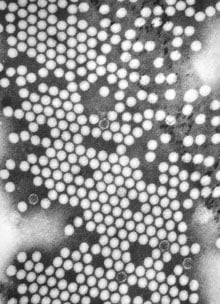The latest version of Post Polio Syndrome includes many new viruses and hundreds of updates. Always use the latest frequencies for best results.
If you find yourself tripping when going up stairs, checking for one of the viruses in this set might help. These, among many other pathogens, can be found circulating on airplane flights or in airports. Probably the most effective health measure on the planet right now would be to put ozone lights in airport and aircraft air circulation systems as Tesla has done in automobiles.
Recent research has surfaced several additional strains of polio virus circulating with the swine flu. These have been broken out into a separate program and those strains commonly found with lyme disease have been incorporated. All these viruses are found in those with post polio syndrome as well as in many people without obvious clinical symptoms.
The lyme complex has hundreds of viruses including organisms like polio virus. The virus is latent in individuals exposed to polio, even though they may have been vaccinated several times so researchers should check for the present of this virus, particularly if they have been exposed to lyme.
Pathogenesis
The primary determinant of infection for any virus is its ability to enter a cell and produce additional infectious particles. The presence of CD155 is thought to define the animals and tissues that can be infected by poliovirus. CD155 is found (outside of laboratories) only on the cells of humans, higher
primates, and
Old World monkeys. Poliovirus is however strictly a human pathogen, and does not naturally infect any other species (although
chimpanzees and Old World monkeys can be experimentally infected).
[31]Poliovirus is an
enterovirus. Infection occurs via the
fecal-oral route, meaning that one ingests the virus and viral replicaion occurs in the
alimentary tract.
[32] Virus is shed in the feces of infected individuals. In 95% of cases only a primary, transient presence of
viremia (virus in the bloodstream) occurs, and the poliovirus infection is
asymptomatic. In about 5% of cases, the virus spreads and replicates in other sites such as
brown fat,
reticuloendothelialtissue, and
muscle. The sustained viral replication causes secondary viremia and leads to the development of minor symptoms such as fever, headache and sore throat.
[33] Paralytic poliomyelitis occurs in less than 1% of poliovirus infections. Paralytic disease occurs when the virus enters the
central nervous system (CNS) and replicates in
motor neurons within the
spinal cord,
brain stem, or
motor cortex, resulting in the selective destruction of motor neurons leading to temporary or permanent
paralysis. In rare cases, paralytic poliomyelitis leads to
respiratory arrest and death. In cases of paralytic disease, muscle pain and spasms are frequently observed prior to onset of weakness and paralysis. Paralysis typically persists anywhere from days to weeks prior to recovery.
[34][35]In many respects the
neurological phase of infection is thought to be an accidental diversion of the normal
gastrointestinal infection.
[15] The mechanisms by which poliovirus enters the CNS are poorly understood. Three non-mutually exclusive hypotheses have been suggested to explain its entry. All theories require primary viremia. The first hypothesis predicts that virions passes directly from the
blood into the central nervous system by crossing the
blood brain barrier independent of CD155.
[36] A second hypothesis suggests that the virions are transported from peripheral tissues that have been bathed in the viremic blood, for example muscle tissue, to the spinal cord through nerve pathways via
retrograde axonal transport.
[37][38][39] A third hypothesis is that the virus is imported into the CNS via infected
monocytes or
macrophages.
[8]Poliomyelitis is a disease of the central nervous system. However, CD155 is believed to be present on the surface of most or all human cells. Therefore receptor expression does not explain why poliovirus preferentially infects certain tissues. This suggests that tissue
tropism is determined after cellular infection. Recent work has suggested that the
type I interferon response (specifically that of interferon alpha and beta) is an important factor that defines which types of cells support poliovirus replication.
[40] In mice expressing CD155 (through genetic engineering) but lacking the type I interferon receptor, poliovirus not only replicates in an expanded repertoire of tissue types, but these mice are also able to be infected orally with the virus.
[41]This frequency set is available on the Frequency Foundation subscribers blog.
